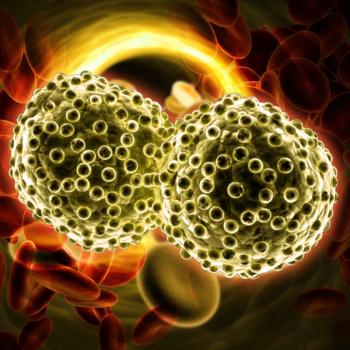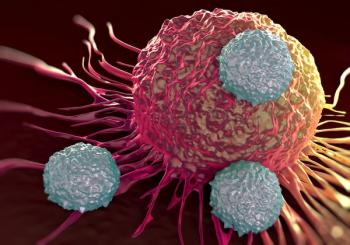
Oncology NEWS International
- Oncology NEWS International Vol 11 No 5
- Volume 11
- Issue 5
Targeted Filgrastim Support Allows Planned Chemotherapy Doses
SAN ANTONIO-Targeted support with G-CSF (filgrastim, Neupogen) based on cycle 1 ANC (absolute neutrophil count) nadirs improves the delivery of planned-dose-on-time chemotherapy and significantly reduces the incidence of febrile neutropenia and related hospitalizations, according to study from The University of Texas M.D. Anderson Cancer Center study using a prospective risk model. Edgardo Rivera, MD, assistant professor of breast medical oncology, presented the results at the 24th San Antonio Breast Cancer Symposium (abstract 3).
SAN ANTONIOTargeted support with G-CSF (filgrastim, Neupogen) based on cycle 1 ANC (absolute neutrophil count) nadirs improves the delivery of planned-dose-on-time chemotherapy and significantly reduces the incidence of febrile neutropenia and related hospitalizations, according to study from The University of Texas M.D. Anderson Cancer Center study using a prospective risk model. Edgardo Rivera, MD, assistant professor of breast medical oncology, presented the results at the 24th San Antonio Breast Cancer Symposium (abstract 3).
Full-dose chemotherapy is associated with prolonged survival, but according to large multicenter studies, approximately 20% of early breast cancer patients receive less than 85% of planned doses. Neutropenia is the primary reason for dose delays and reductions, Dr. Rivera said. Primary prophylaxis with colony-stimulating factors is an alternative treatment option to chemotherapy dose modifications. "Filgrastim reduces the risk of hematologic complications and helps maintain planned doses on schedule; however, filgrastim support as primary prophylaxis is only offered to 3% of patients," he said.
Retrospective risk models suggest it is possible to identify patients at high risk for neutropenic events and target them for filgrastim support. In the Silber Predictive Risk Model (J Clin Oncol 16:2392-2400, 2435-2444, 1998), the lower the cycle 1 ANC nadir, the higher the probability of neutropenic events with subsequent cycles. Silber’s model was retrospectively evaluated using 143 early breast cancer patients at M.D. Anderson. The analysis found that the first-cycle ANC nadir was the sole significant predictor of neutropenic events and was associated with reduced chemotherapy doses.
The current study implemented the Silber model in a prospective multicenter trial of 624 patients with stage I-III breast cancer receiving adjuvant Adriamycin/cyclophosphamide (AC), cyclophosphamide/methotrexate/fluorouracil (CMF), cyclophosphamide/Adriamycin/fluorouracil (CAF), or doxorubicin followed by CMF.
The first cycle of chemotherapy was administered without filgrastim support; then patients were assigned to risk groups based on cycle 1 ANC nadirs. Patients with a first-cycle ANC nadir of 500/mm³ or less were assigned to the high-risk group; patients with nadir greater than 500/mm³ were designated low risk. High-risk patients received filgrastim for all subsequent cycles starting 24 hours after chemotherapy and continuing to ANC of 10,000/mm³ or higher. Low-risk patients received filgrastim secondary to a febrile neutropenic episode or a delay due to neutropenia.
The patients were matched with 1,022 historical controls by regimen, disease stage, age, and baseline ANC.
Study Results
Overall, there was a 75% reduction in the number of patients who received less than 85% of planned-dose-on-time chemotherapy, compared with historical controls: 5% of study subjects received a reduced dose vs 22.8% of controls.
The rate of hospitalizations for febrile neutropenia was also significantly less for study subjects (2.9% vs 7.3%) as was the rate of febrile neutropenia (7.5% vs 10.3%), Dr. Rivera reported.
The benefits of greater drug delivery and less neutropenia were maintained for patients aged 60 and older. Timely dose delivery was more than five times greater among patients aged 18 to 59 and more than three times greater in patients over 60, compared with historical controls.
A matched pairs analysis of 614 pairs also showed the value of targeted colony-stimulating factors: 13% of historical controls received less than 85% of planned-dose-on-time chemotherapy, compared with 4.5% of study subjects. Febrile neutropenia occurred in 10.5% of historical controls vs 7.3% of study subjects, and hospitalizations for febrile neutropenia in 6.3% and 2.7%, respectively. All differences were significant.
Articles in this issue
over 23 years ago
Prognosis Good for Local Recurrence After Lumpectomyover 23 years ago
Long-Term Use of Actiq Safe and Effective for Breakthrough Painover 23 years ago
Youth Exposed to Tobacco Promotionsover 23 years ago
Green Tea May Help Prevent Certain Gastrointestinal Cancersover 23 years ago
EGFR Inhibitor Effective as Salvage Therapy for NSCLCover 23 years ago
Low Risk of CHF With Paclitaxel/Trastuzumab Adjuvant Rxover 23 years ago
Anxiety, Depression in Women at High Risk for Breast Cancerover 23 years ago
NCCN Updates its Treatment Guidelines for Breast Cancerover 23 years ago
Danny Glover ‘Acting’ as Spokesman for Anemia LifeLineover 23 years ago
Health Care Spending Expected to SoarNewsletter
Stay up to date on recent advances in the multidisciplinary approach to cancer.

















































































